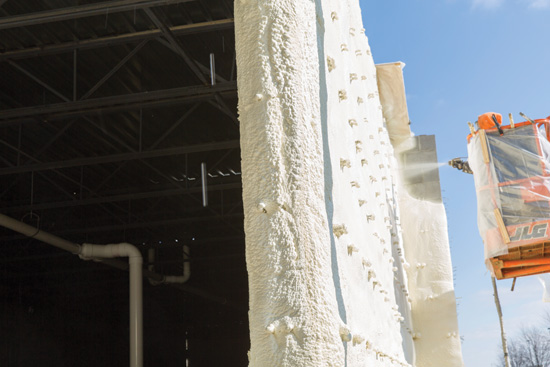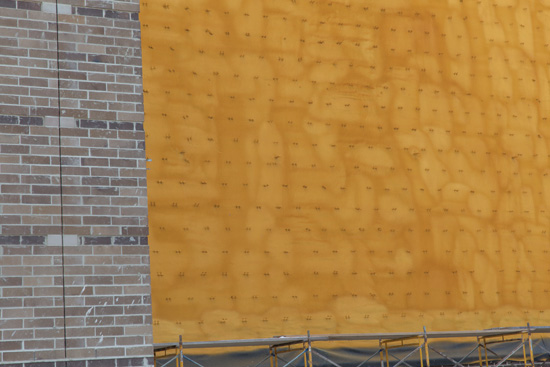Continuous Insulation: Spray Foam Compared to Rigid Boards
Dimensional Stability
Once in place, all building materials are subject to movement from expansion and contraction due to thermal changes. The less a material moves, the more dimensionally stable it is. Similarly, materials that are formed such as concrete and foam insulation are subject to internal shrinkage as the material cures or ages. Picking an appropriate insulation product that does not suffer from movement in either of these cases is important for sustained, continued performance. Some rigid insulation board product manufacturers are keenly aware of the movement of their products and have issued guidelines for leaving gaps or spaces to accommodate that movement, particularly over large expanses. Of course, doing so does compromise the continuity of the insulation. Similarly, some foam board products may shrink or warp over time which also creates spaces or gaps between the boards.
Polyurethane spray foam insulation by comparison is known for exhibiting minimal, or at worst, acceptable levels of expansion and contraction, even in conditions of extreme relative humidity. That means it has been shown to be very dimensionally stable within wall assemblies in different conditions. Closed cell spray foam insulation is also not prone to cell structure change, which means that shrinkage is rare. This is significant since it is important that the insulation stays in place and does not shrink away from the surfaces it is sprayed onto. Note that buildings can creep or settle, which can impact the performance of foam. In cases where this is a concern, the use of termination bars can be employed to help create a long-term mechanical bond between the spray foam and substrates or membranes.
Fire Resistance
Both spray foam insulation and rigid foam insulation board products are considered combustible, just like many other building materials are. Nonetheless, their installation is allowed in non-combustible assemblies provided that the thermal barrier requirements in the Building Code are met. That means that the insulation needs to be protected and isolated with an appropriate barrier such as gypsum board, masonry, etc. and/or meet specific fire safety code requirements. The standards for determining fire safety are found in several well-known standards.
ASTM E 119 Standard Test Methods for Fire Tests of Building Construction and Materials is intended to evaluate the duration of time that building elements contain a fire, retain their structural integrity, or exhibit both properties during a predetermined test exposure. A wall assembly that incorporates spray foam insulation with a proper thermal barrier can meet the requirements of this testing for fire resistance. In terms of flame propagation, NFPA 285 has become the referenced code standard for exterior wall assemblies. The notable point about NFPA 285 compliance is that it is based on testing the whole wall system, not just the product. Therefore, manufacturers typically prepare, and have independent laboratories test, common wall assemblies using their insulation products and have the results made available for designers to reference. Non-typical assemblies and NFPA 285-compliant walls can be determined on a case-by-case basis relying on engineering evaluations if not actual testing. Hence it may be necessary to consult with manufacturer's technical staff or consultants to determine the suitability of a custom or non-standard wall assembly.

Photo courtesy of ICYNENE, Inc.
Spray foam insulation has been successfully installed to contribute to fire safety and to green building considerations.
It is worth noting when comparing foam insulation products that medium-density spray foam's fire performance characteristics are different than extruded polystyrene foam boards in that the spray foam does not melt at high temperatures. Furthermore, although medium-density spray foam products are considered combustible according to the code, they will not sustain a fire once the fire source is removed.
Cold Temperature Applications.
Rigid insulation board can generally be applied in all temperature ranges subject to the limitations of the expansion and contraction of the material and the temperature tolerance of fastening materials (i.e. adhesives). Similarly medium-density spray foam products can be applied in cold conditions and to cold substrate materials in accordance with installation guidelines. Some are particularly useful for cold weather work since they can be successfully applied to substrates as cold as 5°F (-15°C). This capability makes it an industry leader for winter time use as exterior continuous insulation. Other spray foams have cold temperature capabilities with substrates allowed to be a minimum of 22°F (-5.5°C) for an application. Some contractors are trained to take steps to optimize the installation of foam products. For instance, sometimes an insulation contractor can use certain unique application techniques to compensate for cold weather including “following the sun” and using a thin first pass of material.
Green Considerations
Properly used and installed, all insulation will help reduce the use of energy for heating and cooling in buildings, which will help with sustainable and green building performance. When comparing spray foam and board insulation however, there are several notable differences. First, spray foam can more completely and fully insulate and seal a building without joints, gaps, or other interruptions in the continuous insulation. That can mean better energy efficiency for buildings of all shapes and sizes. Second, there is normally no waste associated with spray foam compared to board insulation since only the amount of material needed is used. Boards often need to be cut to fit producing scraps and waste. Third, since spray foam is delivered in liquid form, a tractor trailer load of it can hold a significantly greater amount of board feet of insulation than a truck load of rigid foam insulation boards.
Finally, the process for producing spray foam insulation compared to board insulation is different not only in the base material used but also in the type of blowing agents used. Those blowing agents have been independently rated and range widely in terms of Global Warming Potential (GWP). Spray foam with 100 percent water blown technology offers the lowest rated GWP of 1. By contrast, XPS chemical blowing agents carry a dramatically higher GWP of over 1,000. It is easy to see which one is more environmentally sustainable based on those numbers.
To elaborate more on the performance issues of rigid and spray foam insulation, we can look further at the three main considerations—thermal resistance, air sealing, and water-resistive barrier properties.
Thermal Resistance
Integrating continuous insulation in exterior wall assemblies has received considerable attention in recent years for many good reasons. Energy codes and standards recognize that this construction approach dramatically increases the effective thermal performance of a wall by eliminating heat flows through non-insulated components such as framing and structural members. This “thermal bridging” as it is referred to, is thus eliminated, resulting in increased wall energy efficiency and greater comfort for occupants. For example, the proper use of an exterior continuous insulation system can result in the elimination of some of the most common thermal bridges that often plague a building, such as direct thermal conductivity through metal or wood wall stud framing, perimeter concrete floor edges, and exposed concrete and steel structural columns and beams. The test of a truly effective continuous insulation system is, therefore, the degree that it fully covers all areas of a building assembly and eliminates thermal bridges.
Outside of the structure, the method of securing and attaching the insulation and the cladding material can become an issue. Rigid insulation that requires mechanical fasteners obviously can compromise the continuity and integrity of the insulation. Using adhesive or other means to secure the insulation in place without penetrating it with fasteners is clearly preferred. With spray foam insulation, this is not an issue since the material has its own adhesive properties to keep it securely attached in place once applied.

Photo courtesy of ICYNENE, Inc.
As a continuous air and water-resistive barrier, spray foam insulation seals completely around attachments such as these brick ties.
Similarly, connectors or anchors for attaching cladding, whether for thin systems such as metal or fiber cement or thicker systems such as brick and masonry, can be a factor in the wall assembly. Rigid foam boards are commonly available in 2-foot widths for the purpose of fitting above and below such connectors or anchors that are spaced 2 feet apart vertically. Often, that means that there can be a horizontal gap along the joints of the foam boards which compromises the full insulating performance of the system. This can be exacerbated if there are unusual details or irregular shapes along the wall which alter the spacing of the cladding connectors and result in imprecise field cutting of the insulation.
Spray foam insulation, on the other hand, covers and seals around all connectors and attachments completely. There is also greater flexibility with regard to attachment placement and configuration since a slightly bent or misaligned anchor can still be sprayed around without requiring re-alignment. This all minimizes the disruption in the continuity of the insulation, reducing it to only the actual thickness of the attachment materials. Overall, spray foam covers the wall construction completely and creates a much more uniform layer of continuous insulation.









